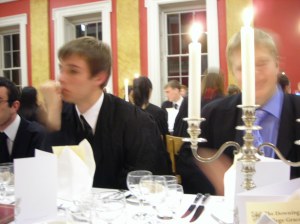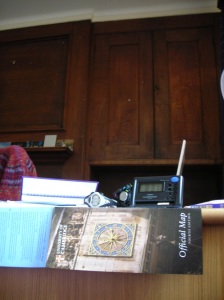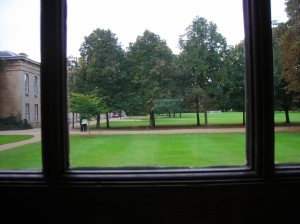Yes, I’m at school, and while I’m all for having fun, meeting nice people, exploring unfamiliar places and experiencing a different culture, I’m also here to learn. And learning sometimes means sitting at a desk for six hours, watching squirrels and birds run around in the sunshine, or attempting to make sense of a phase diagram or philosophical argument that were never intended to be easily understood.
I’m taking four modules in the Engineering department (a normal course-load would be five) plus a class that will count towards my HASS (humanities, arts and social sciences) requirement at MIT. For the whole year, I’ll be earning roughly the same number of credits as if I were at MIT, so I can take a normal senior-year set of courses when I get back and still graduate on time. If you’re my family, or have too much free time, or are curious what MechEs do at other schools, keep on reading to see what classes I’m taking!
3C1: Materials Processing and Design
This will count towards 2.008 (Design and Manufacturing 2) at MIT, but does not involve the canonical injection-molding yo-yo project. It’s manufacturing engineering as an extension of material science, so I’ve had to do some catch-up work on materials: a lot of it looks familiar from Solid-State Chemistry freshman year, and I’m understanding all the material in lectures without much trouble.
3C7: Mechanics of Solids
In 2.001 we learn about Mechanics of Materials, simple beam theory, and how physics applies to solid objects. Here, we realise that simple beam theory is a little too simple to describe real things accurately, and all the pretty little equations that had three variables in 2.001 suddenly have 5 or 6. Halfway through the first lecture, Prof Burgoyne introduced a particular equation by saying “in the first year, you would solve this problem this way, but now we’re going to look at it a little differently,” and I nodded and though to myself, “Yes, that’s exactly how we did it in 2.001. This new way looks pretty interesting.” I think that means I’m in the right class. 🙂
3G1: Introduction to Bioscience
Well, I took AP Biology, and then last spring I took Biochemistry, so I’ve seen almost all of this twice before, but it’s still nice to hear it again with an engineering perspective, and I like having one class where I don’t have to worry too much about making sense of everything: I need to review the material, and double-check that I know what it means, but this class won’t have me up all night puzzling out a derivation or frantically trying to memorise key vocabulary.
3G4: Medical Imaging and 3-D Computer Graphics
This is one of those cool engineering classes where everything is placed clearly in context, and so the material seems very real, rather than being some abstract equation eight degrees removed from the physical world. In the first part of the course, we ran through the medical imaging techniques, how they work in a physical and mathematical sense, and what their specific advantages and applications are. Right now we’re looking at how graphic imaging programs translate visual data into mathematical meshes, and how these are stored and manipulated. I think the next topic is more general computer imaging. With a couple more hours of Differential Equations review, I’ll be able to explain how a CT scanner draws cross-sectional pictures from a series of single-axis slices.
HPS IB: The History and Philosophy of Science.
This is sort of two subjects rolled into one, but they refer back and forth pretty often, and all the NatSci (Natural Sciences) students who choose this course take both. We’ve looked at ancient Babylonian mathematics, Assyrian astrology, alchemy, and Hume’s writings on probability and causation, among other things. This course is very popular with the MIT crowd, as it doesn’t conflict with other classes, and offers humanities credit without getting thrown in with a bunch of English majors.
The big change from MIT is that there aren’t any problem sets. So rather than having three or four assignments due each week, and a test every two or three weeks, I don’t really have deadlines. For HPS, we complete an essay each week, but it isn’t graded, and is primarily a way of organising our ideas so that we can have an effective conversation during supervision (more on that later). For engineering courses, there are two examples papers each term, which are sheets of old exam problems, or small parts of exam problems thrown together into a quasi-Problem Set. These likewise aren’t graded, but it’s a way for us to see what material we need to focus on, and what questions we need to ask in supervision in order to clarify whatever we didn’t quite understand from lecture and reading. Engineering modules each have a two-hour lab, once during the term, so I’ll have to write four short lab reports, and one full technical report, to go along with those labs. These are the only assignments I have this term that go towards my grade, so everything else is very much self-guided, and will be assessed only at the end of the year, in final exams. Yikes!
Supervisions: another one of those Cambridge-y things that is unique to Cambridge (and Oxford, if I’m being totally honest). These complement the two-hours-per-week action-packed lectures: the closest thing we have in the States are recitations (MIT), also knows as precepts or sections. It’s the small-group arena where questions are encouraged, there’s no formal plan, and the content of the meeting will be governed by what the students want to talk about. For HPS, I have a supervision with one other student, and either a professor (philosophy) or a graduate student (history). Basically it means we sit and talk about the material, discuss the readings, and share what we said in our essays each week. Engineering supervisions have three or four students, are based off of an example paper, and only take place two or three times each term. I haven’t had one yet, so I can’t really say what they’re like, just what I’ve heard.
By the end of this week, I will have completed the last of my four Engineering labs, had my second Philosophy of Science supervision, and completed first-round examples papers in three courses. More importantly, the term will be half over. Remember how at MIT we get 5th-week flags, which are right after the first exam, and serve as the early warning that you really need to be spending a little more time on the problem sets? Cambridge students get 5th-week blues: the sense of panic at realising the term is half over, the depression that accumulates from four weeks of full-time lecture, reading, writing and thinking, and the general exhaustion as the days get shorter and colder and lecturers get more complicated. Having already suffered through second-week blues, and third-week panic, I’m hoping to avoid the 5th-week round. Wish me luck!





